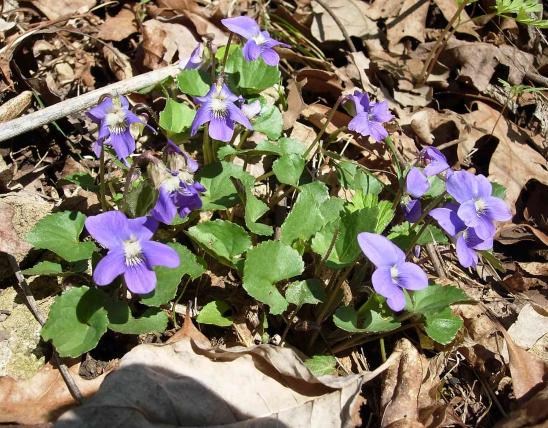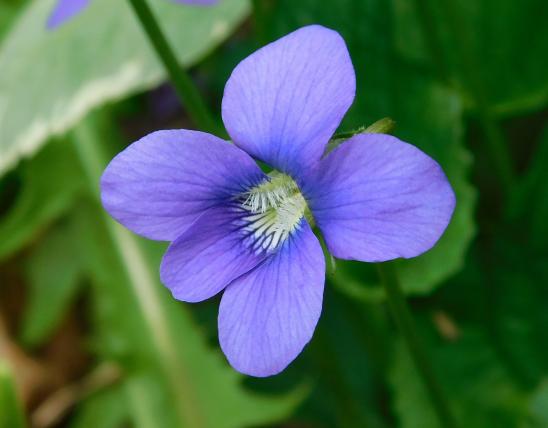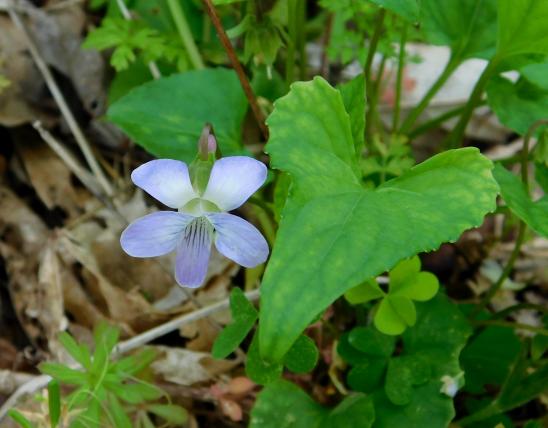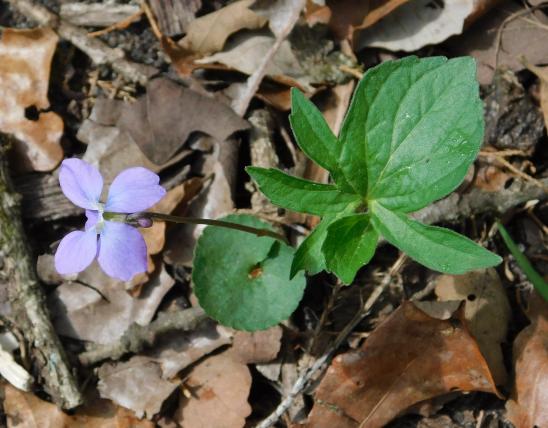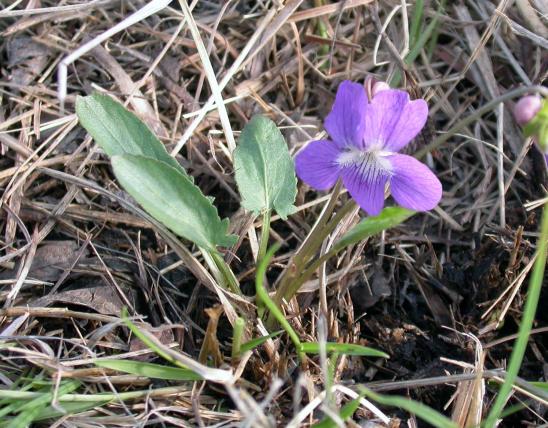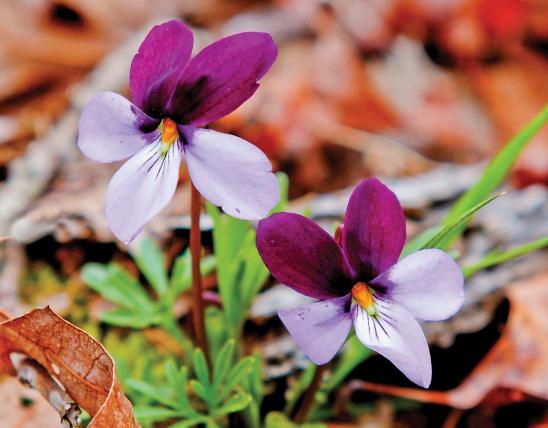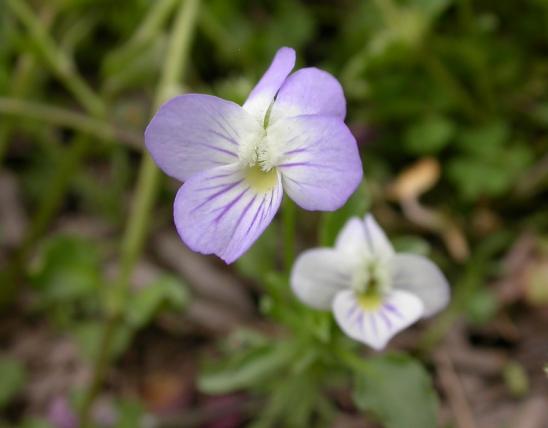
Pale violet, or cream violet, is one of 17 species of violets in Missouri. A native herbaceous perennial wildflower, it is one of our easiest Viola species to identify. It is Missouri’s only white-flowering violet that produces true aboveground stems.
Violets with true aboveground stems produce a stem(s) from the rootstock, with leaves and flowers attached to the stem. (This contrasts with stemless violets, which have each leaf and flower with a separate leaf stem or flower stem that arises individually, in a whorl, from the tip of the rootstock.)
The flowers of pale violet are white to pale cream-colored, with darker, purplish veins. Blooms April–June.
The leaves are alternate on the plant stem. The blades are ovate to heart-shaped and narrowly angled or tapered at the tip. Even without flowers, this species can be identified by the stipules at the bases of the leaves, which are rather large, leafy, with a fringe of slender, deep teeth or lobes.
To learn more about Missouri's violets (genus Viola) as a group, visit their group page.
Similar species: Some other Missouri violets may occasionally occur in white forms, such as the common violet (V. sororia) and bird’s-foot violet (V. pedata), and two other (less common) species always produce white flowers: lance-leaved violet (V. lanceolata) and smooth white violet or northern white violet (V. macloskeyi spp. pallens; syn. V. pallens). All of these are stemless species, however, with the leaf stems and flowers stems arising out of a central, ground-level basal whorl — not attached to an aboveground stem.
Stem length: to about 16 inches. This violet’s long stems can tend to trail along the ground.
Scattered to common in the Ozarks, Ozark border, and Bootheel lowlands; uncommon or absent elsewhere in the state.
Habitat and Conservation
Occurs in bottomland forests, rich (mesic) upland forests, banks of streams and rivers, fens, bases and ledges of bluffs, and margins of upland prairies, glades, and savannas; also fencerows, roadsides, and occasionally cultivated in woodland gardens and can naturalize in nearby disturbed-soil areas. Prefers calcareous soils, such as those derived from limestone. Often abundant in moist to wet silty loam soils.
Status
Native Missouri wildflower. Can be used in native wildflower gardening.
Human Connections
Violets are a favorite sign of springtime in Missouri. They are enjoyed by native wildflower gardeners as blooming groundcovers or naturalized in woodland plantings or in rock gardens. Though rather small, they are gratifying to grow, since they are valuable to wildlife ranging from butterflies to the variety of birds and mammals that browse their leaves and fruit capsules. Get starts of these plants from reputable wildflower nurseries.
Some types of violets may be considered weeds in lawns. Yet they are effective native groundcovers that provide food for wildlife. As people become more aware of ground water quality and stream health, habitat loss, and plant and animal conservation, native plant landscaping and environmentally friendly “freedom lawns” are becoming more popular.
Violets are edible plants. The flowers are not flavorful, but they are beautiful as a decoration. You can gather pale violet flowers and the blossoms of common violet (bluish purple) plus henbit and redbud (magenta and pink) and use them as a perfect springtime garnish on green, pasta, or egg salads, in soups, atop deviled eggs, and in other dishes. You can sprinkle them atop a cake or other dessert just before serving. The leaves are edible, too, and hold significant amounts of vitamin C. You can cook them as a potherb or toss them in alongside other salad greens.
Violets have many historical uses globally as medicinal plants.
Ecosystem Connections
Violets are the food plants for the caterpillars of several kinds of moths and butterflies, including some notable, nifty ones: the giant leopard moth, the regal fritillary, plus most other fritillary species, which are all colorful, medium-sized to large butterflies.
Pollination is carried out by various flies, bees, butterflies, and more.
Like many other perennial herbaceous wildflowers, violets help hold the soil, preventing erosion, and provide forage for many grazing animals. Many songbirds, rodents, and other animals eat the seeds.
The slightly later and relatively long blooming period for pale violet reflects its growth pattern; it must grow out its stem before it blooms, but as the stem continues to grow, it keeps producing new flower buds.
Like many other violets, pale violet produces nonopening, cleistogamous flowers, which typically begin to form later in the spring and summer and are usually hidden below the leaves. Having these flowers is a strategy that helps these rather small wildflowers to reproduce even when larger plants start to cover them, making them more difficult for pollinators to find.
Pale violet and many of its relatives can disperse seed in two ways. The first is a forceful, mechanical ejection as the fruit dries and pops open. The second involves myrmecochory (mur-muh-co-cory). In this process, the seeds are carried away to new locations by ants. Violet seeds have a special nutrient-rich structure on the outer surface called an elaiosome (ell-eye-uh-soam), which ants find delicious. The ants carry the seeds into their nests and eat the elaiosomes or feed them to their young. The ants then move the uneaten, still fertile portions of the seeds to their nest’s waste-disposal area, where the seeds can germinate in a cozy, protected, nutrient-rich environment.






























